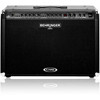Behringer V-TONE GMX212 Manual - Page 14
Appendix - footswitch
 |
View all Behringer V-TONE GMX212 manuals
Add to My Manuals
Save this manual to your list of manuals |
Page 14 highlights
14 V-TONE GMX1200H/GMX212/GMX210/GMX112/GMX110 User Manual ¼" TRS headphones connector strain relief clamp sleeve ring tip sleeve ground/shield ring right signal tip left signal Fig. 6.2: 1/4" stereo TRS connector for AUX and PHONES 6.2 Speaker connection The GMX110 and GMX112 feature a SPEAKER connector to which you can connect an additional loudspeaker. This additional loudspeaker should be able to handle at least 30 Watts @ 4 Ω (GMX110) and 60 Watts @ 4 Ω (GMX112) respectively. The GMX212 and GMX1200H feature two LOUDSPEAKER-outputs (EXT LEFT and EXT RIGHT) for connecting two loudspeakers or a single stereo loudspeaker unit. The output power rating is 60 W per channel. To assure optimal power delivery from the amp, you should use 8-Ω loudspeakers that can handle at least 60 Watts. This goes for all models: You can also use loudspeakers with higher impedance values, but this lowers proportionally the power delivery as the resistance increases. Doubling the impedance halves the power value (double the Ohms = half the Watts). ◊ Since SPEAKER and LOUDSPEAKER outputs are connectors where amplified signals are given out, never connect equipment with line-level inputs to these two connectors, e. g. mixer inputs. 6.3 MIDI connection The MIDI standard (Musical Instruments Digital Interface) was first developed at the beginning of the '80s, with the goal of enabling mutual communication between electronic instruments of various manufacturers. Over the years, the number of possible MIDI applications has increased substantially; nowadays, it is perfectly normal to connect entire studios via MIDI. At the center of this network is a computer with a sequencing software, used to control not only keyboards but also effects processors and other peripheral equipment. In such a studio, you can control your V-TONE in real time from a computer. Using a MIDI footswitch presents itself as a great idea, especially in live applications, because it allows you to control not only effect parameters but also switch between channels and effects. The standard 5-pole DIN MIDI connector is located on the rear of your V-TONE. To connect your V-TONE with other MIDI equipment, you will need a MIDI cable. Pre-packed cables available at music stores are used for this purpose. Such cables should not be longer than 15 m (45 ft). MIDI IN receives MIDI control data. The receiving channel is adjusted using the CHANNEL and IN/OUT key combination On = Omni means that MIDI data are being received and processed on all channels (compare section 4.2). 7. Appendix 7.1 MIDI implementation MIDI Implementation Chart Function Transmitted Recognized Basic Channel Default Changed X X Mode Default Messages Altered X X X Note Number True Voice X X Velocity Note ON Note OFF X X After Keys X Touch Channels X Pitch Bender X Control X Progr. Change True # X System Exclusive X System Common Song Pos. Song Sel. Tune X X X System Clock X Real Time Commands X Local ON/OFF X Aux All notes OFF X Messages Active Sense X Reset X OFF, 1 - 16 OFF, 1 - 16 1, 2 X X X X X X X X X O O 0 - 99 123 124 127 X X X X X X X X X X Notes O = YES, X = NO Mode 1: OMNI ON Mode 2: OMNI OFF Tab. 7.1: MIDI implementation Parameter Name Display Range Volume Controller Channel Select Effect Bypass Parameter 3 Parameter 2 Parameter 1 (MIX) Wah / Modulation Controller Mod FX send on/off Reverb send on/off Delay send on/off Tap Tempo Tuner Bypass Volume * for details see Tab. 4.1 - Channel 1 = 0 Channel 2 = 1 OFF = 0 ON = 1 depends on effect * depends on effect * depends on effect * - - - - - - Tab. 7.2: V-TONE MIDI controllers 7.2 Effect presets Midi Control Number 7 10 11 12 13 14 27 21 22 23 64 82 Remarks memorized see add. table 123 = Channel 1 124 = Channel 2 127 = Tuner Control Value Range 0 .. 127 0, 1 0, 1 0 .. 127 (max.) 0 .. 127 (max.) 0 .. 127 (max.) 0 = off 1 .. 127 0/127 0/127 0/127 value > 63 0 .. 127















